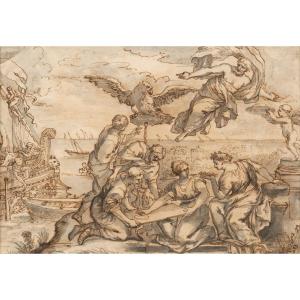Both extravagant and poetic, our composition is a synthesis of Mannerist art in Flanders at the end of the 16th century. In order to strike the eye, the bodies are exaggeratedly stretched, the mannered poses are multiplied and the acidulous colors are widely applied. And as if to signify the knowledge of the protagonists, some of them wear Phrygian headdresses or caps on which Greek and Latin letters are inscribed. The scene describes the famous episode from the Gospel according to John (chapter 8, verses 1 to 11) which will give rise to the consecrated expression "let the first stone be cast at her". This Gospel passage can be summarized as follows: While Jesus was in the Temple, the scribes and Pharisees brought to him a woman caught in adultery. According to the Law, she should be condemned to stoning. But Jesus, questioned by these men, stoops down to write something on the ground and says to them: "Let him among you who is without sin be the first to throw a stone at her." Hearing these words, they all withdrew. By thus denouncing the hypocrisy of his opponents, Jesus prevents the execution of the woman. But what did he write on the floor of the temple? No one knows, only hypotheses are formulated and some biblical scholars suggest that, quoting the prophet Hosea, he would have written these words: "I will not take into account the prostitution of your daughters, the adulteries of your daughters-in-law, since you yourselves (the priests) go aside with the prostitutes..." Finally, Christ's movement is decisive: by turning towards the ground and writing, he does not cast an accusing gaze on this woman. On the contrary, his averted gaze is salutary, cutting short hysteria and false trial.
Dimensions: 72 x 105 cm – 89.5 x 122 cm with frame
Sold with invoice and certificate of expertise
Biography:
The Master of the Prodigal Son is a Flemish painter active in Antwerp in the second third of the 16th century. This conventional name was given to him in reference to an important painting kept at the Kunst Historisches Museum in Vienna: "The Prodigal Son among the Courtesans". Like all anonymous people, nothing is known about his life, but his works, by their particular manner, have been able to be gathered by historians around this paragon. Many of them are kept in museums: Satan Sowing the Tares at the KMSK in Antwerp, Pietà at the National Gallery in London, Christ and the Pilgrims of Emmaus at the National Museum in Warsaw and the Works of Mercy at the Valenciennes Museum.











































 Le Magazine de PROANTIC
Le Magazine de PROANTIC TRÉSORS Magazine
TRÉSORS Magazine Rivista Artiquariato
Rivista Artiquariato